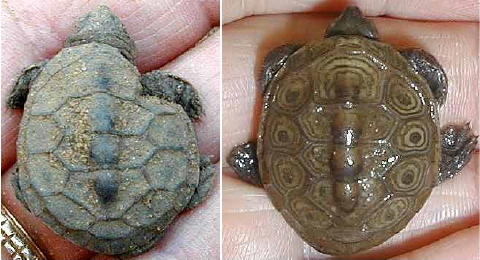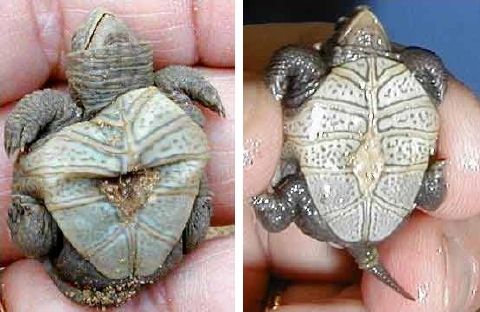Seventy-two hours of warmth and hydration have transformed the tiny deformed hatchling Knotch. Little remains of the distortions caused by root predation and drought. Today she looks as normal as any emerging “fall†hatchling — with one minor exception (more of which anon). The before and after shots are amazing and I would have suspected trick photography, had I not snapped the images myself.
Miraculous Improvement in “Knotch” HatchlingÂ
You recall the right side of her carapace was horribly dented and distorted. Yet, look at her shell today.
Amazing Improvement in “Knotch” PlastronÂ
Even her plastron has responded to treatment and has largely rebounded to near normal. Only a slight indentation remains along the abdominal scutes on either side of her residual yolk sac, but you can see how much of the original distortion has evened out.Â
Over-Wintered Hatchling “Knotch” Awaits Release
And what’s the “minor exception†that distinguishes Knotch (and Ott, too; see “Of Things Big and Small†on 12 May) from hatchlings that emerge from the nest in the fall? I must admit that I missed it myself until I woke with a start in the middle of the night in a “Eureka!†moment. “By Golly, that’s what seemed so odd. I knew something was missing.†And, of course, it was.
What? The egg tooth. Those Wellfleet hatchlings, which overwinter in the nest, pip through the egg shell in the fall, but remain buried underground inside the opened shell in the nest’s egg chamber. So it’s no surprise the egg tooth disappears during the winter before these late bloomers emerge in the springtime.
The weather has been a little chilly with temperatures still dropping into the mid-40s and the wind blowing off the Atlantic. So, Knotch has remained in her makeshift terrarium for a little longer than anticipated. It has all the comforts, and a lot more safety, than her nursery marsh habitat. But even for tiny, defenseless hatchlings, there’s no place like home.


